This time we made a stress test of a low-cost mobile phone Nokia 2700 classic. It comes with the accessories that are common for any handset: battery charger and headset (pic. 1, 2). The cell phone looks cheap and does not seem ruggedized at all (pic. 3, 4). There is a band made of a chromized plastic. It runs round the housing faceplate
We must say that it’s pretty hard to press the keys of the phone. The key travel is not deep and the keys are so close together that you may press the wrong key accidentally.
Results
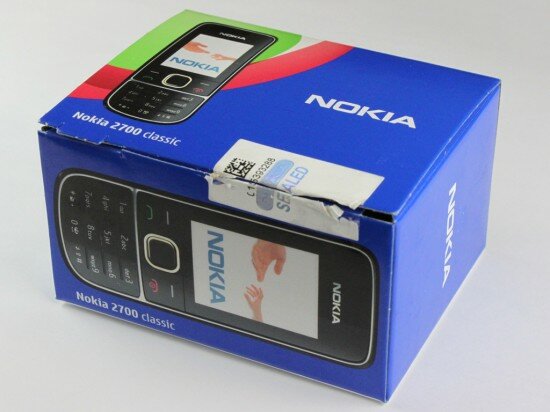
Pic. 1. Delivery box

Pic. 2. Accessories

Pic. 3. Front side
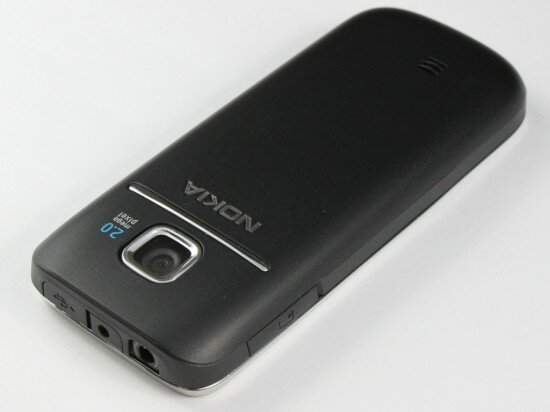
Pic. 4. Back side
1. Nokia 2700 classic stress test. Stage 1 – Light shocks
1.1 Drop test
We started the experiment with a drop test as usual. We sequentially dropped the phone onto each face, edge and corner from 1 m (3 ft) on the carpet and from 30 cm (11,8 inches) on the ceramic tiles. All in all the device fell 6 times.
Fall on the carpet did not cause any damage to the Nokia 2700 (video 1). When we dropped the gadget on the tiles the battery door opened but the battery did not fell out of the slot (video 2). The phone passed the test with no damage.
Video 1. Drop on the carpet from 1 m (3 ft)
The grade is 30 from 30 possible
Video 2. Drop on the tiles from 30 cm (11,8 inches)
The grade is 30 from 30 possible
1.2 Squeeze test
In the squeeze test we put the phone on a table and applied a 3 kg (6,6 lbs) pressure from a wooden bar above (pic. 5). It was not enough to cause any damage. The device passed the test successfully.

Pic. 5. The phone under the 3 kg wooden bar
The grade is 24 from 24 possible
1.3 Bend test
Bend test has a lot in common with the squeeze test. The only difference is pressure. It is not spread all over the handset. It is concentrated in a particular area. We simulated the situation when a person sits down with their cell phone in a back pocket. Actually we put the Nokia 2700 onto the two planks so that each edge of the phone lay on a plank. Then we hitched a string with 1 kg (2,2 lbs) load over the handset. The result – no bend. Please look at picture 6 to be sure that the phone passed the test.

Pic. 6. Bend test
The grade is 24 from 24 possible
1.4 Durability
In this test we checked how durable the gadget was. We put it in our “time machine” (a drum) together with keys, plastic things and pennies to simulate what might be happening in a man’s trouser pocket while carrying a phone for a long time. The drum was rotating for 5 min at the speed of 500 rpm (video 3).
This time the phone was damaged. To tell the truth we expected this bad result. The band that runs round the housing faceplate suffered most of all (pic. 7). The chrome was scuffed in some area and the plastic was seen under it. But the back cover was not seriously damaged. There were only small scratches at the bottom of the battery cover. You can also notice some scuffs and scratches on the screen glass only if you look carefully.
Video 3. Drum rotation

Pic. 7. Damage of the plastic band running round the housing faceplate
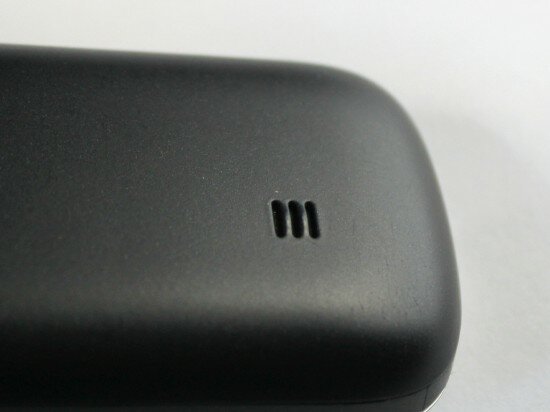
Pic. 8. The back cover
Anyway the grade is 18 from 24 possible
1.5 Scratch test
In order to test the material quality of the screen glass and the back cover we scratched this parts of the phone at the force of 100 g (0,22 lbs) (video 4, 5). The scratches were insignificant and we could see this damage only when the light fell on the handset at a certain angle.
Video 4. Screen scratching
The grade is 15 from 15 possible
Video 5. Scratching the back cover
The grade is 15 from 15 possible
1.6 High temperature
If you leave your cell phone in the sun or near an open fire for a long time it will propbably look awful. The plastic parts of a gadget may melt and its performance may change for the worse.
In order to know whether the Nokia 2700 can withstand high temperatures we put it in a metallic container 5 cm (1,968 inches) far from an electric bulb (40 Wt) to simulate what might be happening to a cell phone after lying in the sun for a long time. The bulb was heating the phone for 3 min (video 6).
After the test we examined the device. It did not melt and it performed with no probems. It was easier to press the keys because they were heated. At first sight the phone was even better than before.
Video 6. High temperature test
The grade is 12 from 12 possible
1.7 Dust test
The more you use your cell phone the more dust accumulates in the seams and slots. It may have a bad impact on the performance of the gadget and even make it stop working. In this test we discovered how the Nokia 2700 can deal with dust. We had an enclosed tray with dust thrown in with the phone. Then we were vibrating it violently for 2 min. After the test we took out the handset and examined it carefully. As far as we can judge the screen is not durable and prone to be polluted by dust plenty of which penetrated under the screen glass (video 9). Grains of dust were clearly seen there especially when the backlight was off. There was no dust in the USB port due to the cap (pic. 10). Some small grains of dust penetrated under the battery cover and under the camera lens through the seam between the back cover and the handset (pic. 11).

Pic. 9. Dust under the screen glass
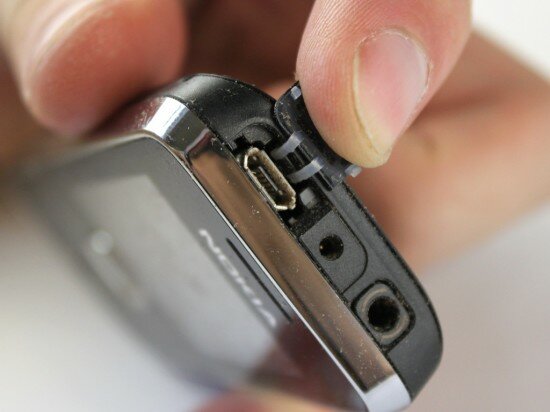
Pic. 10. USB port after the test

Pic. 11. Dust under the camera lens
The grade is 8 from 12 possible
1.8 Connectivity
They say that Nokia cell phones have a good reception quality. To check whether it is true we put the handset into a box and covered the box with foil (the foil served as a shield). Then we made a 45 x 40 mm ( 1,77 x 1,57 inches) hole in the box in order to let the phone receive the electromagnetic waves sent from a tower (video 7).
There were 3-4 bars of the signal strength when we made a call. When we took it out of the box the strength of the signal was maximum again. The phone received all the calls.
Video 7. Connectivity test
The grade is 15 from 15 possible
After the 1st stage of the stress test the Nokia 2700 classic got 183 (from possible 192)
2. Nokia 2700 stress test. Stage 2 – Tough conditions
2.1 Drop test
At the second stage of the drop test the height of the fall on the carpet was 1,5 m (4,9 ft) and the height of the fall on the tiles was 50 cm (1,64 ft). When we dropped the handset on the carpet the battery caver fell off (video 8). Nothing bad happened to the phone after the fall on the tiles (video 9). Even the plastic band covered with chrome was not damaged in this test.
Video 8. Drop on the carpet from 1,5 m (4,9 ft)
Video 9. Drop on the tiles from 50 cm (1,64 ft)
The grade for the drop on the carpet is 30 from possible 30
The grade for the drop on the tiles is 30 from possible 30
2.2 Squeeze test
In this test we increased the applied pressure to 10 kg (22 lbs). The result was the same as in the first stage of this experiment. The handset is flat and solid. Due to this the phone passed the squeeze test successfully.
The grade is 24 from 24 possible
2.3 Bend test
This time we increased the applied pressure to 5 kg (11 lbs). The bend was very small. The result – full survival.
The grade is 24 from 24 possible
2.4 Durability
In the result of the first stage of this test the band around the housing faceplate was damaged greatly. The chrome was scuffed. But we decided to discover what would happen if we increased the time of the drum rotation to 10 min.
This time more chrome was scuffed. Black spots came out on the band. That was the plastic. The band got dalmatian colouring (pic. 12). There were a lot of scuffs on the screen glass but the display was quite clear (pic. 13). There also appeared more scratches on the back cover (pic. 14).
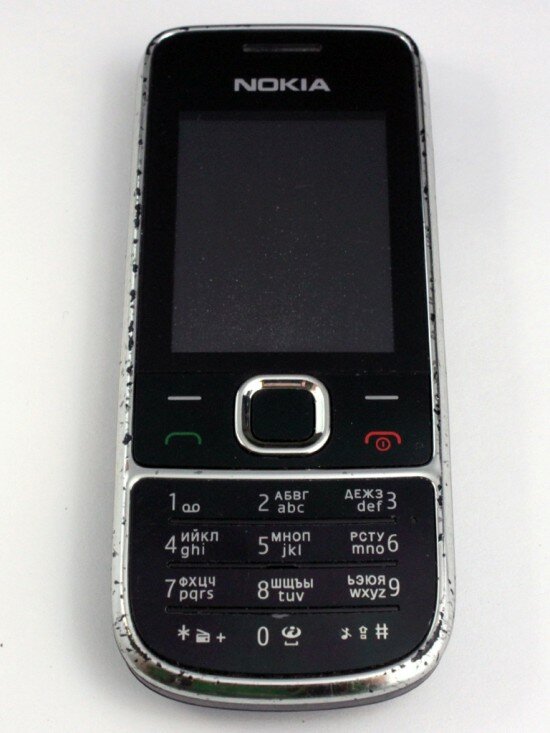
Pic. 12. The handset after the test

Pic. 13. Damage of the screen glass

Pic. 14. Scratches on the back cover
The grade is 10 from 15 possible
2.5 Scratch test
This time we increased the force of scratching to 300 g (0,66 lbs). The scratch on the screen was deep and noticeable. It made the display unclear no matter the backlight was either on or off. The scratch on the back cover was not so deep but it was clearly seen in the bright light.
Video 10. Screen scratching
Video 11. Scratching the back cover
The screen gets 10 points from 15 possible
The back cover gets 10 points from 15 possible
2.6 Freeze test
In cold weather a cell phone battery capacity usually becomes small very fast. The display may glitch and the keys are often difficult to press. In order to know whether the Nokia 2700 classic can survive extreme cold temperature we put it n a freezer for 2 hours. The temperature was -15 °C (5 °F) and the phone was in a speaking mode. When the time of the test was over we took the phone out. There were 3 bars of the battery capacity. The capacity was reduced by the cold but we could not say that it was low. Vice versa that was a good result. But the display glitched a bit. The keypad was the weakest part of the phone in this test. It was very hard to press the keys because they were frozen and did not do their job. When we warmed the phone it started to perform well again and there were maximum 4 bars of the battery capacity.
Video 12. Freeze test
The grade is 12 from 18 possible
2.7 High temperature
At the second stage of this test the handset spent 5 min. under the electric bulb. The phone keyboard melted a bit (video 13). Fortunately there was no other damage.
Video 13. High temperature test
The grade is 8 from 12 possible
2.8 Immersion in water
Even a small amount of moisture can wreak havoc on an electromic device. A cell phone may be damaged even if you take it by a wet hand. In spite of this we dunked the Nokia 2700 under water for 1 sec. (video 14). The phone passed this test quite well. The battery cover protected the Nokia from water. However little amount of moisture penetrated inside through the seam between the back cover and the handset (the seam that is under the camera). The USB port was dry due to the cap (pic. 15). All the electronic components were absolutely safe.
Video 14. Immersion in water for a second

Pic. 15. No water in the USB port
The grade is 30 from 30 possible
2.9 Dust test
This time we were vibrating the enclosed tray with dust and the phone for 5 min. The battery door opened and the battery fell out of the slot when the handset was right there. As a result a lot of dust penetrated inside the phone (pic. 16). Many grains of dust got under the screen glass through the seam between the keypad and the screen (pic. 17). The USB port was clean. The keys made an unpleasant noise when we pressed them.
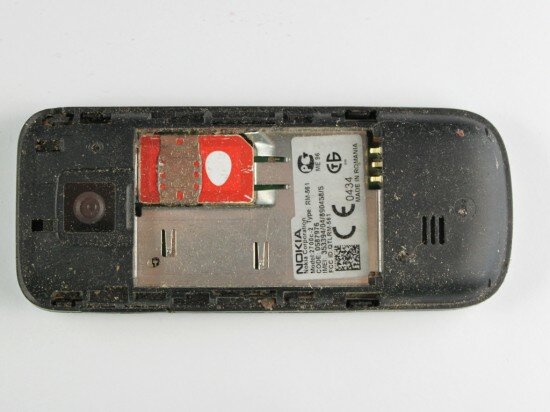
Pic. 16. Battery slot after the test

Pic. 17. Dust under the screen glass
The grade is 8 from 12 possible
2.10 Connectivity
We put the handset in a new box and made a smaller hole in it. The size of the hole was 20 x 20 mm (0,787 x 0,787 inches). So the reception was weaker than in the previous connectivity test.
This time there were fewer bars (2 – 3) that displayed the signal strength (video 15). But the phone received all the 10 call with no problems.
Video. 15 Connectivity test
After the 2nd stage of the stress test the Nokia 2700 classic got 211 (from possible 240)
3. Nokia 2700 stress test. Stage 3 – The toughest conditions
3.1 Drop test
At the last stage of the stress test we dropped the phone on the carpet from 2 m (6,56 ft) and on the tiles from 1 m (3,28 ft) (video 16, 17). The back cover fell off when the phone hit either the carpet or the tiles. But the drop test did not cause any damage. The force of the bump was not great due to the light weight of the handset. May be there were some more cracks on the band that runs round the housing faceplate but it was impossible to distinguish them from the scuffs on the chrome cover.
Video 16. Drop on the carpet from 2 m (6,56 ft)
The grade is 30 from 30 possible
Video. 17. Drop on the tiles from 1 m (3,28 ft)
The grade is 20 from 30 possible
3.2 Squeeze test
In this test we increased the applied pressure to maximum 20 kg (44 lbs). The phone passed the test but we heard an unpleasant noise produced by the grains of dust and sand that accumulated in the seams in the result of the dust test.
The grade is 24 from 24 possible
3.3 Bend test
This time we increased the weight of the load to 10 kg (22 lbs) (pic. 18, video 8). There was a clear bend but it did not had a bad impact on the performance of the gadget. The handset passed the test successfully.

Pic. 18. Bend caused by the 10 kg (22 lbs) load
Video 18. Bend test. The applied pressure is 10 kg (22 lbs)
The grade is 24 from 24 possible
3.4 Durability
We decided to discover what would happen to the plastic band covered with chrome if we increased the time of the drum rotation to 20 min. When the test was over we took the phone out and examined it carefully. Please have a look at picture 19 and you’ll see the handset immediately after the test.
The Nokia 2700 looked really awful. The chrome cover was scuffed greatly. Even the plastic was damaged. Big cracks and deep scratches on the screen glass struck the eyes. The display was not clear any more (pic. 20). The back cover was also badly damaged (pic. 21).
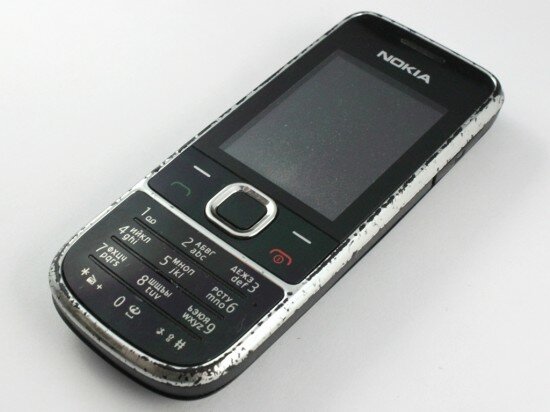
Pic. 19. Dust under the screen glass
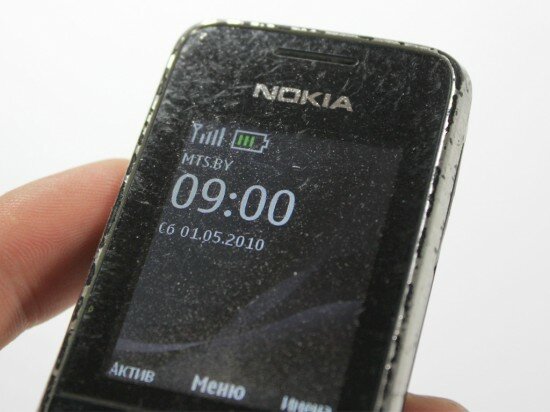
Pic. 20. Cracks and scratches on the screen glass

Pic. 21. Scratches on the back cover
The grade is 10 from 15 possible
3.5 Scratch test
At the third stage of the scratch test the force of scratching was 600 g (1,322 lbs) (video 19, 20). As a result the scratch on the screen was two times wider than in the previous scratch test (consequently it was two times deeper) (pic. 22). The scratch on the back cover was as deep as in the he previous test (pic. 23).
Video 19. Screen scratching
Video 20. Scratching of the back cover
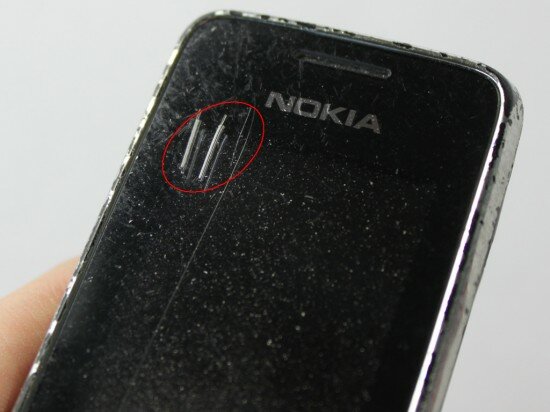
Pic. 22. Scratches on the screen glass
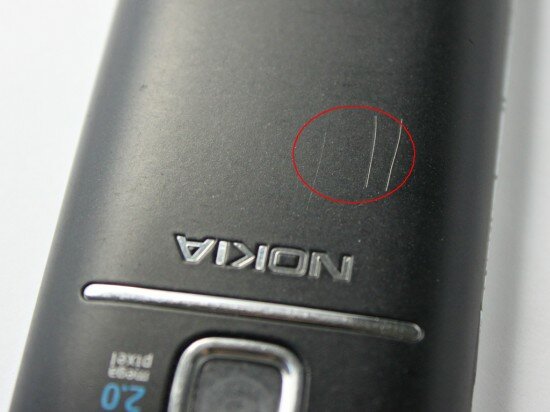
Pic. 23. Scratches on the back cover
The grade for the screen is 10 from 15 possible
The grade for the back cover is 10 from 15 possible
3.6 High temperature
This time the phone spent 10 min. under the electric bulb. The display was heated so much that it became dark. But as soon as we cooled it down the color rendering was normal again (video 21). In addition to the melted keypad we found out that the navigational key unit was a bit deformed by the heat (for more details watch video 21). But all this damage spoiled only the look of the phone. The performance of the device was still almost perfect.
Video 21. High temperature test
The grade is 8 from 12 possible
3.7 Immersion in water
We dunked the Nokia 2700 under water for 20 sec. Then we saw a warning message on the screen telling us that the headset was connected to the phone (video 22). The USB port was dry as usual. However water penetrated under the battery and reached the circuit board (pic. 24).
Video 22. Immersion in water
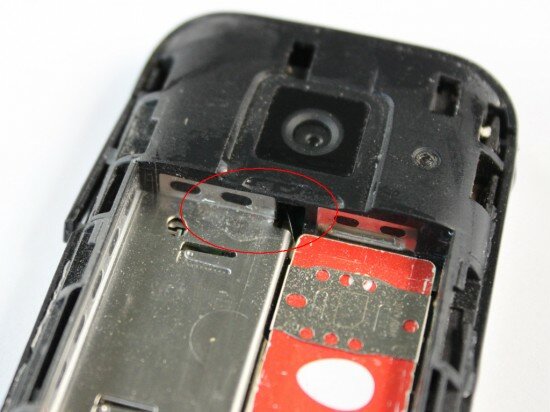
Pic. 24. Water under the battery
The grade is 30 from 30 possible
3.8. Immersion in beer
Anyone can accidentally drop their cell phone in water. But there are more dangerous liquids for an electronic device than water, for example alcoholic drinks. We dunked the Nokia 2700 under beer – the most popular alcoholic drink in the world. This experiment lasted 10 sec. (video 23).
In the previous test (when we dunked the Nokia 2700 under water) the phone warned us about the connection with the headset and we were not surprised. Any Nokia cell phone that we have ever tested always sends such a message though a headset is not connected to the phone. This is a glitch. Especially it happens to the phones without ear microphone caps.
In the result of the immersion in a can of beer the battery suffered a lot. No doubt that the beer reached the circuit board (pic. 25). Even the flash drive was wet though it was absolutely dry after we had dunked the handset under water (pic. 26). Some beer also penetrated in the USB port.
Had we stopped recording the experiment the display went blank. The performance of the device was not stable. The phone switched itself off a few minutes after we switched it on. We disassembled the gadget, washed the circuit board with spirit and dried it out. After that the Nokia started working as if nothing had happened.
Video 23. Immersion in beer
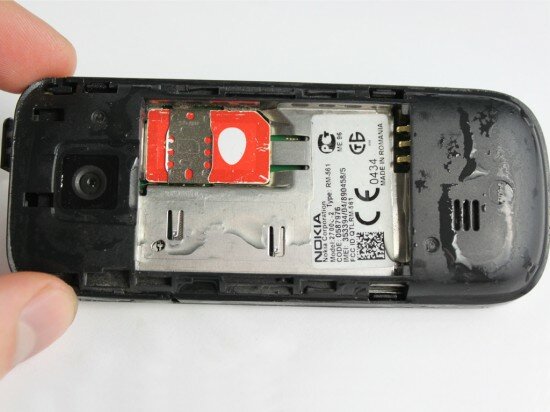
Pic. 25. Spots of beer under the battery
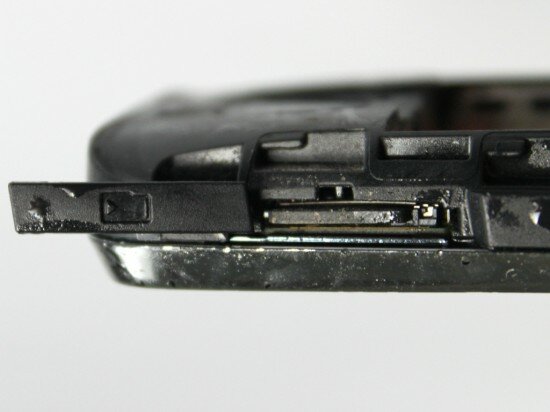
Pic. 26. Spots of beer in the USB
For this test the grade is 4 from 12 possible
3.9 Dust test
This time we put the phone in the enclosed tray for 10 min. Much more dust penetrated under the screen glass than in the previous dust tests (pic. 27). The USB port was full of sand in spite of the fact that it had a cap that should have protected it. Fortunately the battery cover did not fell off as it had been before. But this time a lot of dust accumulated under it. There were even more sand, dust and grime than in the previous stage of this experiment when the handset was in the drum and its back cover fell off (pic. 29). There were few grains of dust under the keyboard. However it produced the unpleasant noise when we pressed the keys.
After the test the Nokia did not charge. Charging was one of the main points in further tests and we decided to repair the phone. We revealed the problem: both the contact points of the circuit board and the charger jack were stuffed with dust. We cleaned it with a brush, assembled the parts of the handset and it started charging again.

Pic. 27. Dust under the screen glass

Pic. 28. USB port full of dust
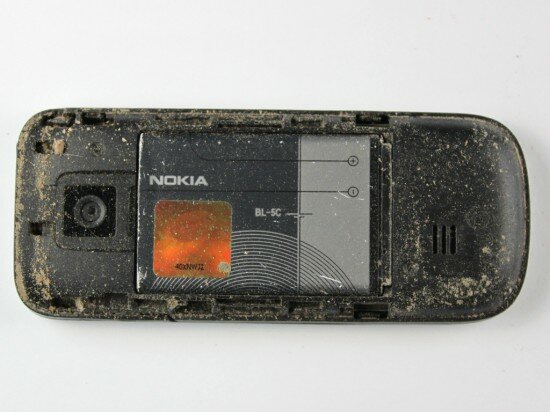
Pic. 29. Dust under the back cover
The grade is 4 from 18 possible
3.10 The keypad
The keypad is a real disadvantage of the Nokia 2700. Instead of making it reliable and user friendly the engineers focused only at its design. However the keypad passed the tests well enough. It was a bit melted by the electric bulb and it lost its attractiveness but anyway the result was quite good. We must also say that it was very hard to press the keys after we took the phone out of the freezer. But the keyboard survived.
The grade is 10 from 15 possible
3.11 Connectivity
For the third time we put the handset in a new box (covered with foil) and made the smallest hole in comparison with the previous two (15 x 15 mm or 0,59 x 0,59 inches). The signal was of the same strength as at the 2nd stage of the test (video 24). The phone received all the 10 calls with no problems. That was a very good result and according to out experience low cost Nokia handsets always pass this test perfectly.
Video 24. Connectivity test
The grade is 15 from 15 possible
3.12 Short circuit and overcharge
We started this experiment with the easiest test – short circuit of the battery. We connected the contact points of the battery “+” and “-“ with the help of forceps. That’s the best way to test the battery (video 25). Watch video 25 and you’ll see the spark produced by the short circuit. However the battery board prevented the cell from discharging. As a result the handset performed quite well with this battery after the short circuit.
Video 25. Short circuit of the battery
The grade is 15 from 15 possible
Then we tested the charger. Actually we did the same. We connected the contact points of the charger with the help of the forceps (video 26). Watch the video and be sure that there were no problems with charging.
Video 26. Short circuit of the charger
The grade is 15 from 15 possible
Then we tested the electronic components responsible for charging. We were changing the power of charging with the help of a Power Supply Unit (PSU). At first we were gradually decreasing the power of charging. The phone stopped charging when the power was 3,8 V. This is not very good. The best result is 4,3 – 4,5 V.
Secondly we were gradually increasing the power of charging. When we reached 6,1 V the phone warned us about the disconnection with the PSU. This is a very good result. So Nokia 2700 classic can protect itself from overcharge.
Video 27. Power of charging increase/decrease
The grade is 15 from 15 possible
At the end we carried out the most dangerous test for the handset – overvoltage. We plugged in the electric power generator instead of the battery (video 28). At first we decreased the power in order to see the state of the phone. We were really surprised when the handset switched itself off when the power was minimum (2,8 V).
We decided that the maximum voltage for the Nokia 2700 should be 7 V. Then we started gradually increasing the voltage. When the power was 6,5 V the phone switched itself off (perhaps it was a glitch of the Nokia). But we did not stop the experiment and reached 7 V. Then we decreased the power, reset the phone, plugged in the electric power generator again and the Nokia started to perform with no problem.
Power consumption was normal throughout all the test. It means that the Nokia is produced to withstand such a power.
Video 28. Overvoltage
The grade is 15 from 15 possible
3.13 Disassembling
After all the tests we disassembled the device (pic. 30). We did not expect to see anything new inside the Nokia 2700. But we were glad that there was something like a steel frame that could make the phone solid. The circuit board is typical. It has a lot of empty space (as all Nokia circuit boards). All the components are shielded (that’s an advantage of the gadget). The charger jack and the ear-microphone jack are connected to the circuit board. Such design requires less money to produce a circuit board but it makes it difficult and more expensive to repair the board. There is nothing to add.

Pic. 30. The phone disassembled

Pic. 31. Nokia 2700 circuit board
The grade is 10 from 15 possible
Conclusion:
Nokia 2700 classic is not a ruggedized device but its design is good. The band that is made of chromized plastic makes it easy to spoil the look of the phone. It makes the handset undurable. This Nokia phone is not dust resistant at all because a lot of sand penetrated under the screen glass and under the battery. The device also failed the test with beer. The keypad is not reliable. It is difficult to press the keys in warm weather and it’s a real challenge to press them in -15 °C (5 °F). Due to its light weight the handset passed the drop test well (but sometimes the battery door opened and the battery fell out).
The Nokia 2700 after the test (video 29, pic. 32, 33).
Video 29. The Nokia 2700 after all the tests
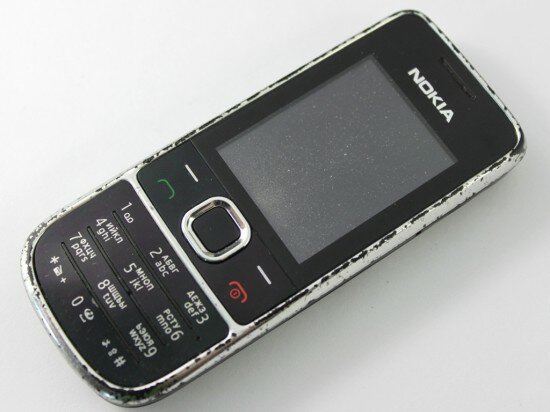
Pic. 32. The front of the phone after the tests
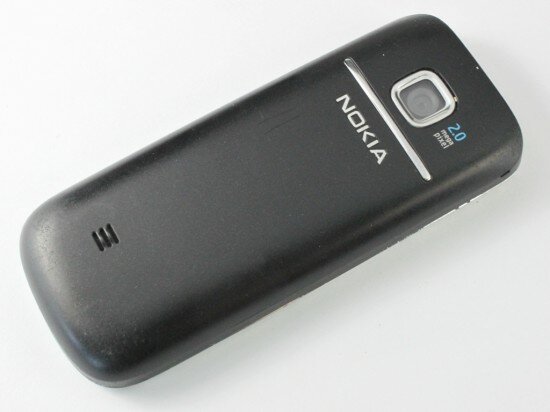
Pic. 33. The back of the phone after the tests

 Russian version
Russian version
Trackback/Pingback (1)
[...] the plastic under it (Pic. 13). To compare to the result showed by the Nokia 2700 in the same test https://gadgetstress.com/2010/10/stress-test-of-the-nokia-2700, we can say that the gunmetal effect edging of the Nokia C5 is quite durable. The part of the back [...]